Physical Address
304 North Cardinal St.
Dorchester Center, MA 02124
Pilar neoplasms differentiate toward (resemble) various parts of the normal hair follicle. They are named according to what they resemble. Before reading this chapter, review the discussion of hair anatomy in Chapter 1 . Blue pilar tumors differentiate toward elements of the inferior segment of the hair follicle. Red pilar tumors differentiate toward the isthmus and infundibulum. Clear cell tumors differentiate toward the glycogenated outer root sheath.
Low-power architecture is a large ball with internal trabeculae (similar in architecture to a proliferating pilar cyst)
Basophilic cells that resemble those of the hair matrix keratinize to form shadow cells (ghost cells)
Often calcify
Giant cell granulomas adjacent to calcifications
Bone formation common
Multiple pilomatricomas are associated with myotonic dystrophy
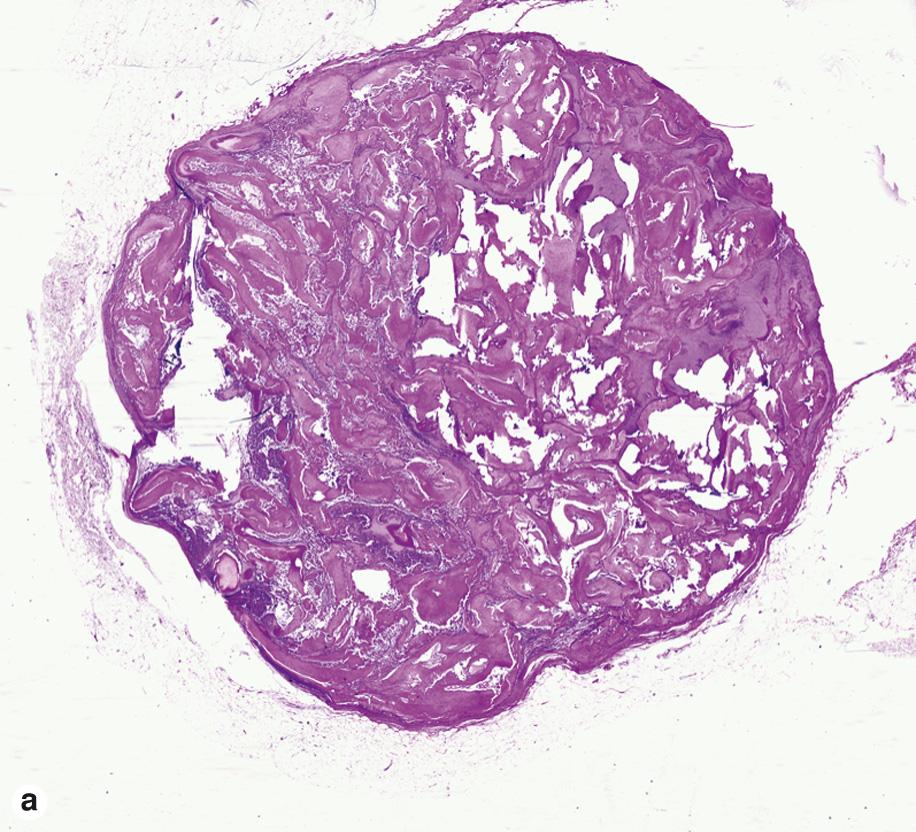
Rare
May arise in long-standing pilomatricomas
Large
Infiltrative border
Atypia, mitoses, necrosis
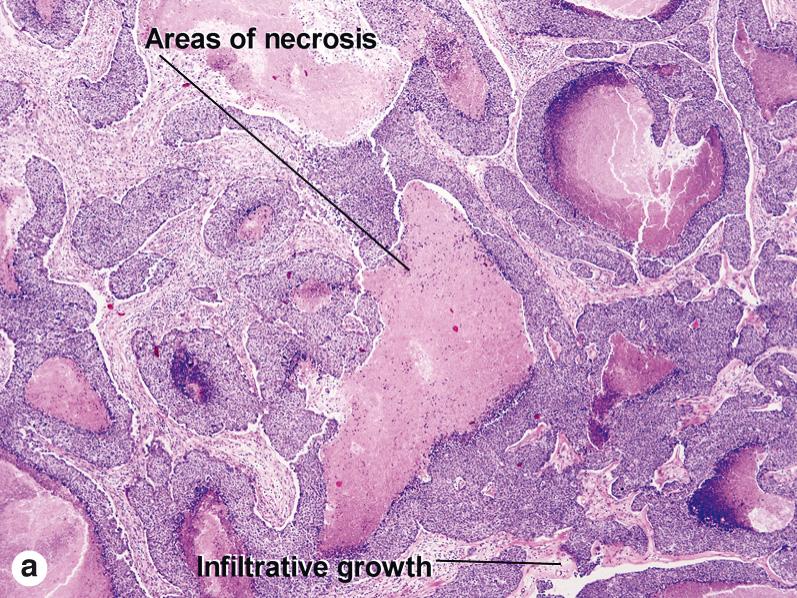
Family of blue follicular tumors composed of basaloid cells
Cells resemble those of basal cell carcinoma
Stroma resembles the normal fibrous sheath of the hair follicle, with concentric collagen and many fibroblasts
Papillary mesenchymal bodies may be present in the stroma
Mucin may be present within tumor islands, but never in the stroma
No retraction artifact
Benign trichoblastomas are large basaloid follicular neoplasms. The tumor islands resemble basal cell carcinoma, but the stroma resembles the normal fibrous sheath of the hair follicle. Trichoepitheliomas and lymphadenomas are distinctive forms of benign trichoblastoma. Trichogerminomas are a type of trichoblastoma with differentiation toward the hair germ. Basal cell carcinoma is the most common malignant counterpart of a benign trichoblastoma. Some trichoblastic carcinomas arising in long-standing trichoblastomas have been very aggressive tumors with metastases.
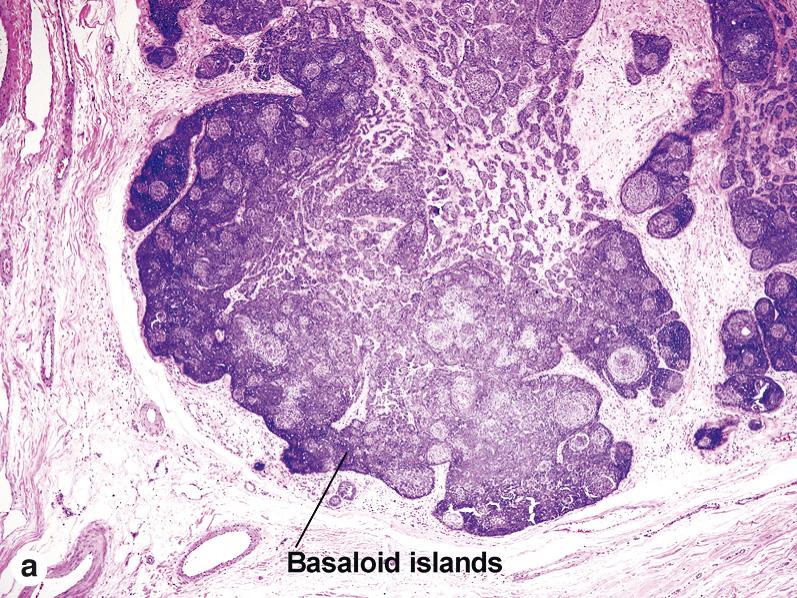
Distinctive type of trichoblastoma
Blue tumor composed of basaloid cells
At scan, fingerlike projections and cribriform (Swiss-cheese) nodules
Cells resemble those of basal cell carcinoma
Stroma resembles the normal fibrous sheath of the hair follicle, with concentric collagen and many fibroblasts (as with any other trichoblastoma)
Papillary mesenchymal bodies typically prominent
Mucin may be present within cribriform tumor islands, but never in the stroma
No retraction artifact
Trichoepitheliomas commonly present as multiple small papules in the nasolabial folds. The multiple type is inherited in an autosomal-dominant fashion. Each papule is composed of basaloid islands in a fibroblast-rich stroma with papillary mesenchymal bodies. Horn cysts and calcification are common. Small clefts may occur between collagen fibers of the tumor stroma, but not between the tumor epithelium and stroma. Papillary mesenchymal bodies are round collections of plump mesenchymal cells resembling those in the follicular papilla.
Multiple trichoepitheliomas (epithelioma adenoides cysticum) inherited as autosomal-dominant trait
Brooke–Spiegler syndrome: multiple trichoepitheliomas and cylindromas
Rombo syndrome: milia, hypotrichosis, trichoepitheliomas, basal cell carcinoma, atrophoderma, vasodilation with cyanosis
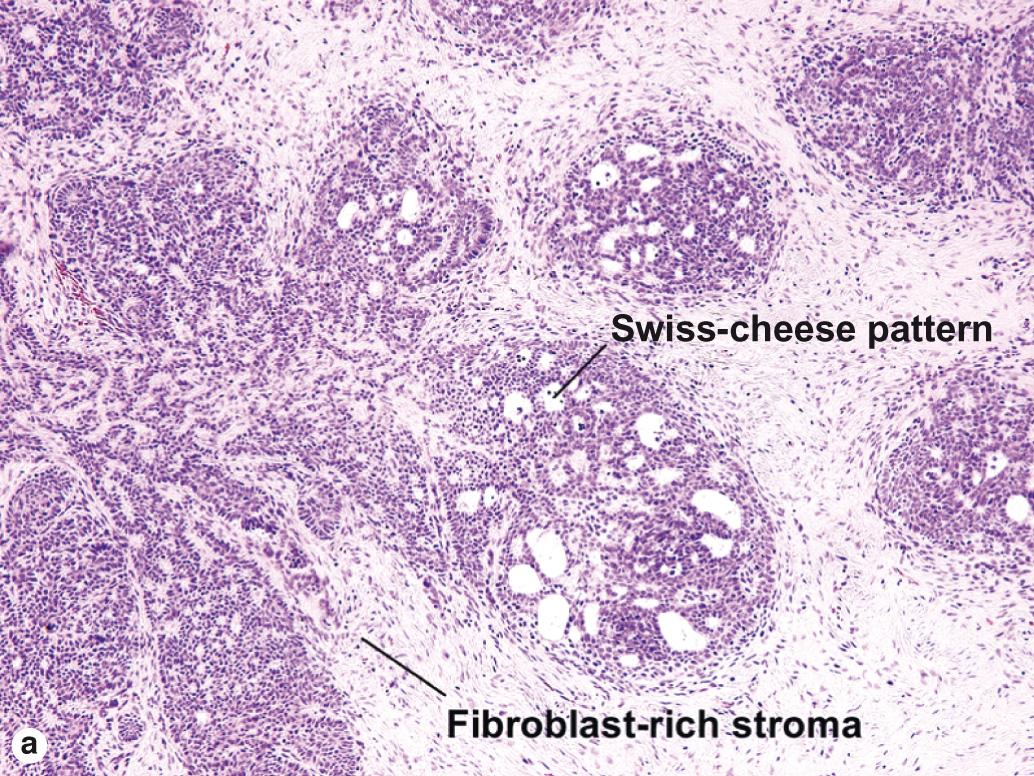
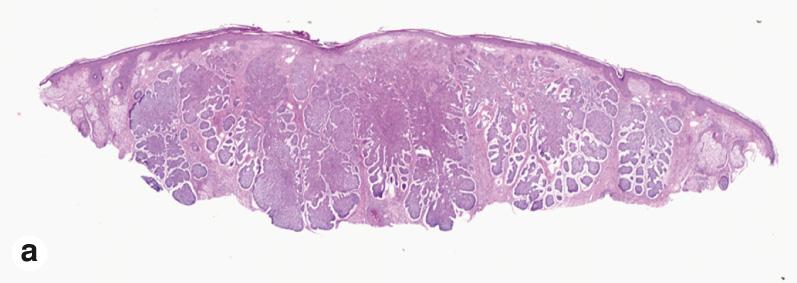
| Characteristic | Trichoepithelioma | Basal cell carcinoma |
|---|---|---|
| Basaloid cells | Yes | Yes |
| Peripheral palisading | Yes | Yes |
| Fingerlike and cribriform | Yes | Sometimes |
| Stroma | Concentric, fibroblast rich | Myxoid |
| Mucin | In tumor islands only, none in stroma | Metachromatic mucin in stroma |
| Papillary mesenchymal bodies | Common | Rare |
| Horn cysts | Common | Rare |
| Calcification | Common | Rare |
| Clefts | Between collagen fibers within stroma | Between epithelium and stroma |
| CD34 staining | Strong staining in stroma | +/− |
| BCL-2 staining | Periphery of islands | Strong, diffuse |
| CK20+ Merkel cells | Present in tumoral islands | Absent in tumoral islands |
Firm doughnut-shaped lesion on a young woman's cheek
Central dell
Paisley-tie pattern (tadpole-shaped islands)
Red desmoplastic stroma
Calcifications common
Horn cysts common
Clefts only within stroma
Desmoplastic trichoepithelioma: doughnut-shaped tumor on the cheek of a young female
Microcystic adnexal carcinoma: firm plaque on the upper lip, medial cheek, or chin
Morpheaform basal cell carcinoma: scarlike lesion in older patient
Eruptive syringomas: chest and back or penis, commonly on skin type VI
Syringomas: small papules on lower lids, very common with Down syndrome and in Asian females
| Characteristic | Desmoplastic trichoepithelioma | Morpheaform basal cell carcinoma |
|---|---|---|
| Paisley-tie pattern | Yes | Sometimes superficially |
| Stroma | Red, sclerotic | Red, sclerotic |
| Horn cysts | Common | Occasional |
| Calcification | Common | Rare |
| Clefts | Between collagen fibers within stroma | Between epithelium and stroma |
| Central dell | Yes | No |
| Age | Younger | Older |
| Clinical appearance | Firm doughnut | Scarlike |
| Characteristic | Desmoplastic trichoepithelioma | Microcystic adnexal carcinoma |
|---|---|---|
| Paisley-tie pattern | Yes | Yes |
| Stroma | Red, sclerotic | Often red, sclerotic |
| Horn cysts | Common | Common |
| Calcification | Common | Rare |
| Lymphoid aggregates | Rare | Typical |
| Perineural extension | No | Yes |
| Clinical appearance | Firm doughnut | Plaque on upper lip, cheek, chin |
| Central dell | Typical | Absent |
| Characteristic | Desmoplastic trichoepithelioma | Syringoma |
|---|---|---|
| Paisley-tie pattern | Yes | Yes |
| Stroma | Red, sclerotic | Red, sclerotic |
| Horn cysts | Common | May occur |
| Calcification | Common | Rare |
| Central dell | Typical | Absent |
| Shape | Broad | Small and round |
| Clinical appearance | Firm doughnut | Small papules |

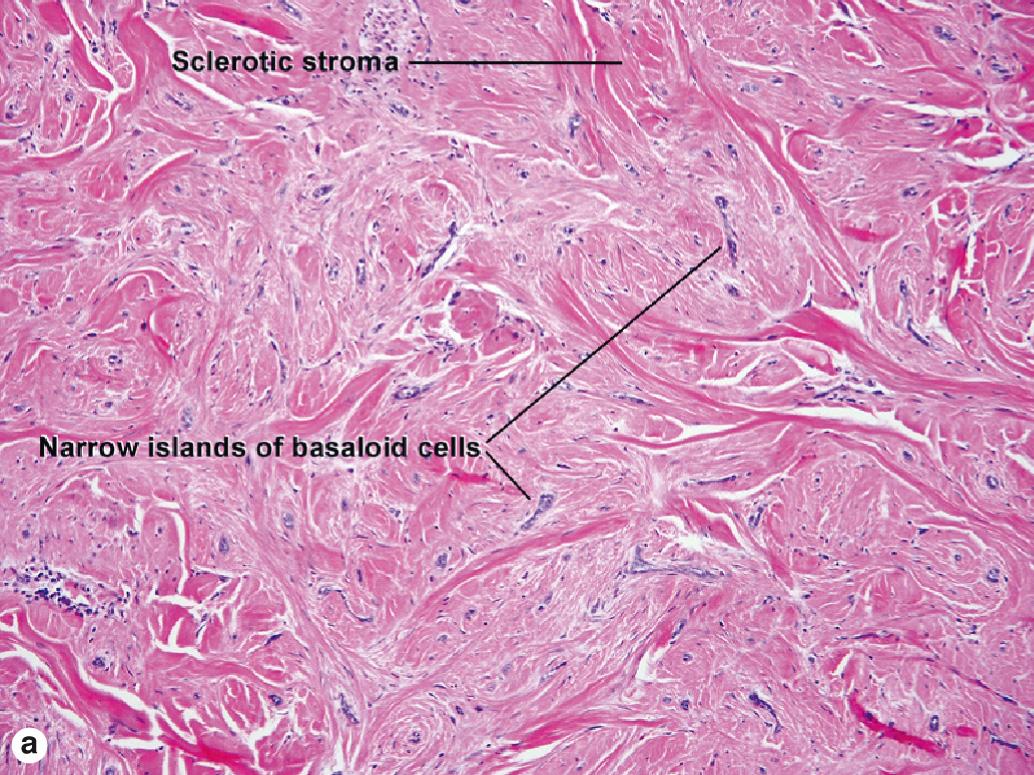
Tumor islands with one to two layers of basaloid cells peripherally
Centers of each island composed of clear cells/inflammatory cells
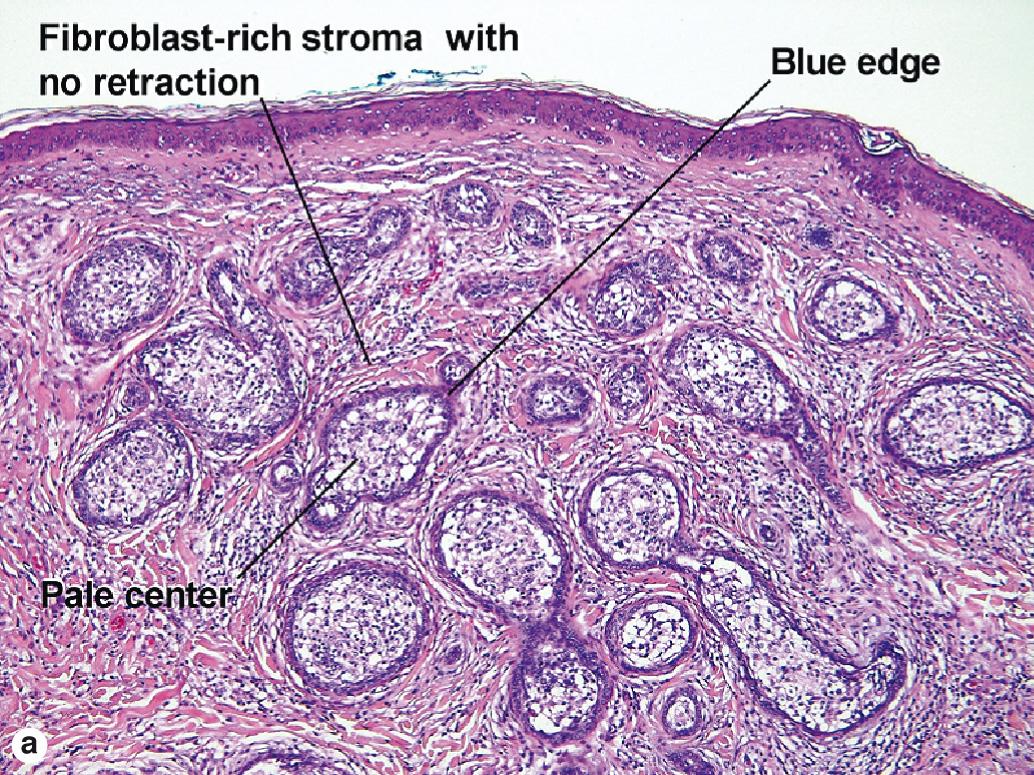
Fibrous pink orb or amphophilic fibromucinous orb
Epithelial strands radiating outward from central follicle-like structure
No hair fibers
In fibrofolliculomas, the strands of epithelium are not well enough differentiated to form hair fibers. No bulb, inner root sheath, or outer root sheath is present. The strands of epithelium may have an anastomosing pattern. Trichodiscomas are simply fibrofolliculomas cut in a plane of section that does not reveal the epithelial strands.
Become a Clinical Tree membership for Full access and enjoy Unlimited articles
If you are a member. Log in here